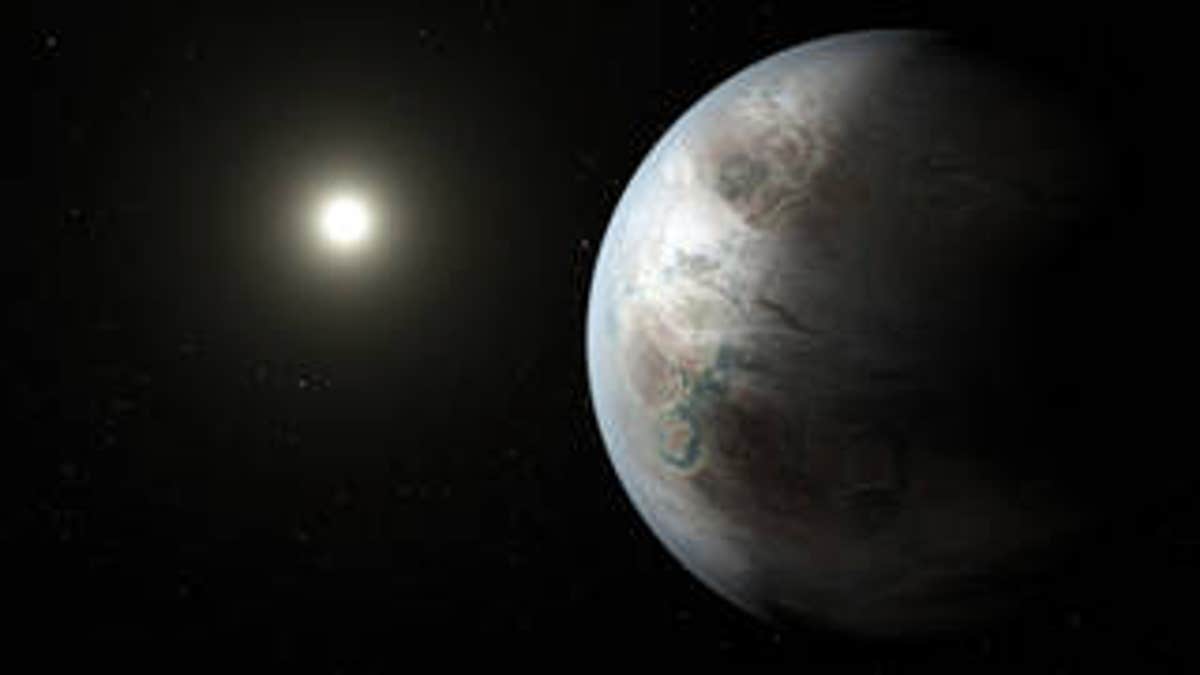
This artist's concept depicts one possible appearance of the planet Kepler-452b, the first near-Earth-size world to be found in the habitable zone of a star that is similar to our sun. (Credits: NASA/JPL-Caltech/T. Pyle)
NASA will make a major announcement related to exoplanets at a press conference at the agency’s headquarters in Washington, DC Wednesday.
In a press release sent out Monday, NASA said that its press event will address a “discovery beyond our solar system.” The press conference, it added will “present new findings on planets that orbit stars other than our sun, known as exoplanets.”
Thomas Zurbuchen, associate administrator of the Science Mission Directorate at NASA Headquarters in Washington will participate in the briefing, along with experts from MIT, the Space Telescope Science Institute in Baltimore, and NASA’s Spitzer Science Center at Caltech/IPAC.
ASTRONOMERS DISCOVER 60 NEW WORLDS, FIND 'SUPER EARTH'
Details of the findings are embargoed by the journal Nature until 1 p.m. EST, according to NASA.
CNET said that it had seen the research in an article published Monday, adding that “while we can't share details yet, let's just say it could very easily provide us with new settings for many future works of science fiction.”
Exoplanets have certainly been in the spotlight recently.
NEW NEIGHBOR: SCIENTISTS DISCOVER CLOSEST HABITABLE EXOPLANET
Last week an international team of astronomers announced the discovery of 60 new planets orbiting stars close to Earth’s solar system, including a rocky “super Earth.”
The experts also found evidence of an additional 54 planets, bringing the potential discovery of new worlds to 114.
One planet in particular, Gliese 411b, has been generating plenty of attention. Described as a “hot super Earth with a rocky surface,” Gliese 411b is located in the fourth-nearest star system to the Sun, making it the third-nearest planetary system to the Sun, according to the U.K.’s University of Hertfordshire, which participated in the research. Gliese 411b (also known as GJ 411b or Lalande 21185) orbits the star Gliese 411 (or GJ 411).
'SUPERFLARES' LIKELY MADE PROXIMA B UNINHABITABLE LONG AGO
Gliese 411 and Gliese 411b are located 8 light years from earth. A light year, which measures distance in space, equals 6 trillion miles.
By way of comparison, the recently-discovered Earth-like planet Proxima b, which orbits the red dwarf Proxima Centauri, is about 4 light years from Earth. A red dwarf is a relatively cool small star.
Proxima Centauri is the star closest to Earth outside of our solar system. Scientists announced the discovery of Proxima b last year, noting that the planet is 1.3 times the size of Earth. Depending on the conditions there, Proxima b could potentially support life, according to experts.
